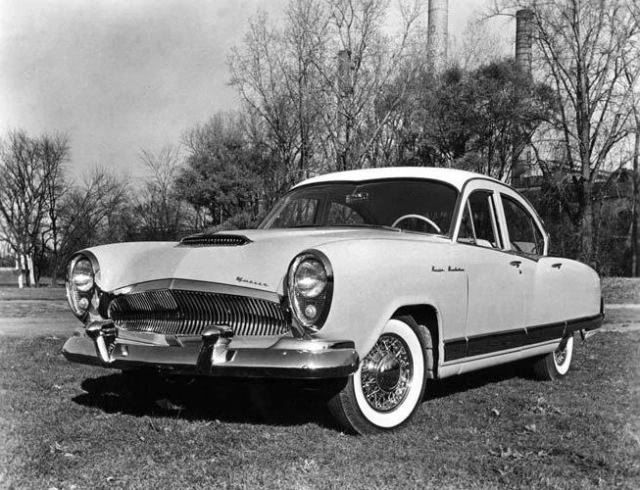Though the production of the Kaiser passenger car seemed not to be restarted after the 1954 model year, this fine automobile makes a short comeback in January 1955. Three months before, Henry J. Kaiser has signed an agreement planning the continuation of the car’s construction in Argentina and, before a plant could be readied in the country, production starts again in America. All cars produced are supercharged Manhattan, almost identical to the models seen last year, and most of them are exported to South America. Nevertheless, a few cars - slightly more than two hundreds - are sold in the United States, along with some unsold 1954 cars fitted with new serial numbers. The last Manhattans are shipped to Buenos Aires in June 1955, and none will be built in the U.S. in the future - the decision is final this time, as all production machinery is soon dismantled and also sent to Argentina.
The firm had chosen the buffalo as its emblem to symbolize its willingness to produce a front-wheel-drive automobile - ironically, it never did, apart from a few prototypes.
Kaiser Manhattan

● Introduction: February 1950 for this generation of Kaiser models, March 1952 for the Manhattan. Construction: body on separate chassis. Engine: water-cooled supercharged inline six, 3.7-litre, 140 hp, mounted at the front. Transmission: to the rear wheels through a three-speed manual gearbox. Three-speed automatic gearbox optional. Suspension: independent at the front, rigid axle at the rear. Brakes: hydraulic, to drums on all four wheels. Servo optional. Length: 536 cm. Top speed: 145 kph. Range: two-door club sedan, four-door sedan.
Any mistake you’ve just spotted? A detail to add? A suggestion? Don’t hesitate to leave a comment!
Click to learn more about the Kaiser's heir, the Argentinean-built IKA Carabela.
Click to jump to another model year of the same car: 1950 – 1951 – 1952 – 1953 – 1954 – 1955
Click here to return to a list of all Kaiser vehicles presented on this blog.
Click here to return to this blog’s initial post, featuring a list of all vehicles already presented.
The firm had chosen the buffalo as its emblem to symbolize its willingness to produce a front-wheel-drive automobile - ironically, it never did, apart from a few prototypes.
Kaiser Manhattan

● Introduction: February 1950 for this generation of Kaiser models, March 1952 for the Manhattan. Construction: body on separate chassis. Engine: water-cooled supercharged inline six, 3.7-litre, 140 hp, mounted at the front. Transmission: to the rear wheels through a three-speed manual gearbox. Three-speed automatic gearbox optional. Suspension: independent at the front, rigid axle at the rear. Brakes: hydraulic, to drums on all four wheels. Servo optional. Length: 536 cm. Top speed: 145 kph. Range: two-door club sedan, four-door sedan.
Any mistake you’ve just spotted? A detail to add? A suggestion? Don’t hesitate to leave a comment!
Click to learn more about the Kaiser's heir, the Argentinean-built IKA Carabela.
Click to jump to another model year of the same car: 1950 – 1951 – 1952 – 1953 – 1954 – 1955
Click here to return to a list of all Kaiser vehicles presented on this blog.
Click here to return to this blog’s initial post, featuring a list of all vehicles already presented.
No comments:
Post a Comment